How to Make a Competitive Analysis Report [Template + Examples]
Table of contents
You absolutely need to know what your competitors are up to. After all, how do you want to compete with them if you don’t do any research? It’s like trying to win a dance battle without knowing if your opponent is a master of salsa or just your uncle at a wedding doing the Macarena. Here’s how to create a top-notch competitive analysis report + some tips and examples on how to do it even better!
Competitive analysis report is a document that briefly outlines competitors’ strengths and weaknesses, identifying your company’s relative advantages and disadvantages.
It provides insights into growth opportunities, such as product improvements, market share, and customer expectations, to enhance competitive positioning.
Competitive analysis is key to understanding your direct and indirect competitors, industry trends, target audience, and other important factors. But how to present this analysis?
The answer is a competitive analysis report!
Without further ado, it’s time to explore what it really is and how to create one that will rock your strategy and give you a winning edge in the game!
What is a competitive analysis report?
A competitive analysis report is a structured document that helps you understand your competitors, their strengths & weaknesses, and their position within the market landscape.
Depending on the defined scope, a competitor analysis report provides insights into your rivals’ sales and marketing strategies, product features, market presence, brand reputation, and more.
The key elements of a competitive analysis report are:
- Clear goals
- Key metrics
- Competitor identification
- Data collection
- SWOT analysis
- Strategic recommendations
- Visuals
All right, let’s cover the second issue. How can you create a competitive analysis report fast? Is there any smart shortcut that speeds up the whole process without sacrificing quality?
Create a competitive analysis report with Brand24!
Gamechanger: a competitive analysis report template
The best way to gain a competitive edge quickly and effectively is to use a tailored, pre-designed competitive analysis template.
Such a framework (of course, when it’s well-crafted; we’ll discuss it further) not only saves time but ensures you don’t miss any critical elements while evaluating your rivals.

Discover our client’s success story — read the case study.
Think about such a case study.
Your manager just asked you to prepare a competitive analysis report, and they need it by tomorrow morning.
You’re staring at a blank document, feeling the pressure mount.
Where do you even start? Do you dive into researching your competitors’ websites, social media, products, or pricing? It feels overwhelming, right?
Now imagine this.
Instead of starting from scratch, you open a well-crafted competitor analysis template.
It’s already organized into clear sections, such as market positioning, product comparisons, reputation benchmarks, and customer insights.
You simply fill in the data, one category at a time. With every detail you fill in, the report comes together seamlessly.
Generate your first competitive analysis report template!
Sounds fantastic, don’t you think?
Where to get the template & data for your competitive analysis? [example]
Okay, another crucial question: where do I get this template and the data for it?
Don’t worry – it’s easier than you think.
There are several options available to get both a ready-to-use framework and the information you need to fill it with.
Let’s start with the template itself.
Create a competitive analysis report fast!
Probably the best source to get a free competitor analysis template is Canva.
This simple but powerful graphic design tool offers many customizable templates to help you create a competitive analysis document that looks great and is easy to adapt.
Register (or log in to) your Canva account, search for “competitive analysis” in their template library, pick a design, and start editing!
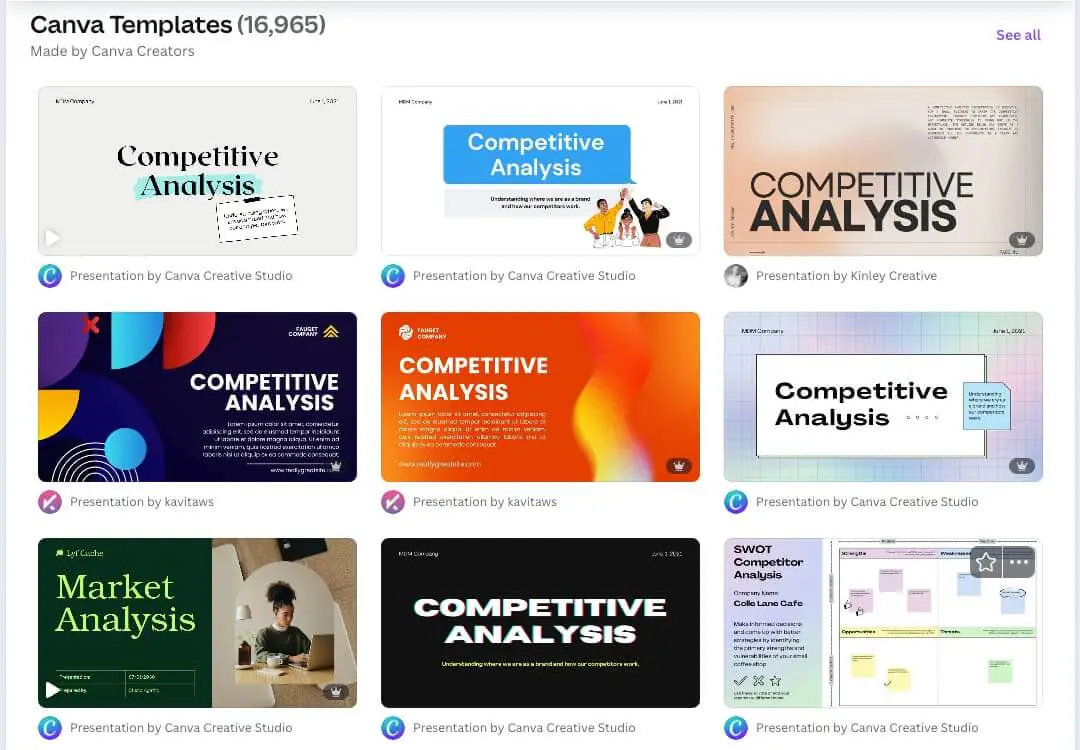
While Canva allows you to pick the framework, it can’t automatically fill it with data. However, there are other tools that can provide both the template and the data for your competitive analysis.
Example?
Brand24, an AI-powered media monitoring tool that tracks and analyzes online mentions, can generate a competitor analysis report within seconds.
With just a few clicks, you can see the competitive analysis based on data coming from:
- Social media, such as Facebook, Instagram, X (Twitter), YouTube, LinkedIn, TikTok, Reddit, Telegram, and Twitch;
- News sites, blogs, video platforms, forums, and other websites;
- Podcasts, review platforms, and newsletters.
All you need to do is visit a Comparison tab, select your competitors, and click “Export to PPTX” (or “Export to CSV” if you’re a fan of Excel sheets).
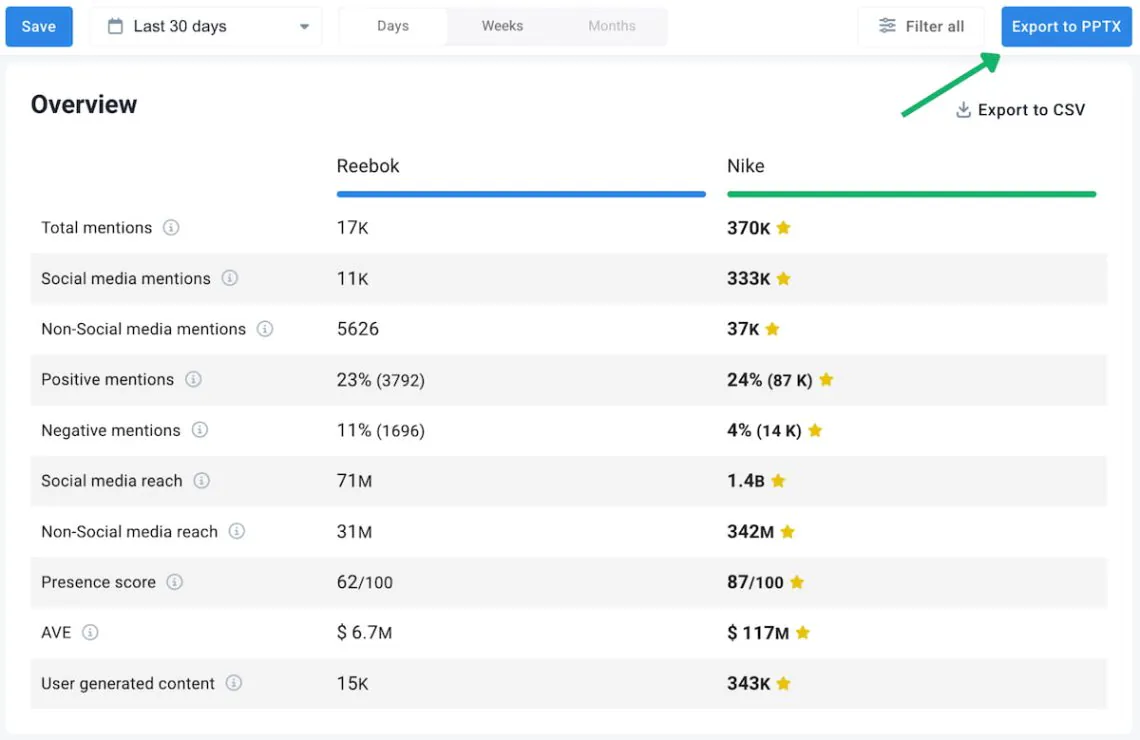
👉 Take a look at the competitive analysis sample report I generated this way (it took me literally 22 seconds).
You can treat it as a competitive analysis report template. Or – if you need a more comprehensive report – this PPTX file is an amazing source of ready-to-fill competitive data about your brand reputation & visibility performance.
Additionally, Brand24 allows you to generate other reports that can serve as valuable data sources for your analysis.
Click and download these free report templates:
👉 PDF Report Example
👉 Interactive Report Example
Create a competitive analysis report with Brand24!
How to create a competitive analysis report? 7 steps
01 Choose your goals
Doing a competitive analysis report without setting goals is like shopping grocery in an all-in-one supermarket without a shopping list.
You take the cart and walk through the alleys without a plan.
Look, there’s a special offer for your favorite cookies! You take three packs.
Wow, there’s a special price for a frozen pizza today! You throw them in the cart.
After coming back home and unpacking shopping, you realize your mistake. Most of your groceries are either junk food or things you don’t really need.
Moreover, all these “special offers” have cumulated, and you’ve ended up spending way more than you planned.
To make matters worse, you forgot the essentials – no fresh vegetables, bread, meat, or milk. You got nothing to make a proper meal.
This exactly happens when you conduct a competitive analysis without setting clear goals.
But once you have them, you set clear boundaries that keep you focused on what’s important.
Understand your competitive advantages! Start trial!
Okay, and how do you set these goals?
Let me suggest you think over the following issues:
1. Understand your purpose.
Why are you conducting this competitor analysis?
Example: You want to increase your website traffic, so you want to discover your competitors’ SEO strategies.
2. Align with business goals.
Your goals should support your broader business or marketing objectives.
Example: Increase monthly traffic by 25%.
3. Set SMART goals.
Your goals should be:
- Specific: Clearly define what you want to achieve.
- Measurable: Use data and metrics to track progress.
- Achievable: Be realistic about your resources and timeframe.
- Relevant: Ensure the goal aligns with your objectives.
- Time-bound: Set a clear deadline for completion.
Example: By March 31st, I will analyze the top five competitors’ blog strategies to identify 10 high-performing keywords for our content calendar.
Competitive analysis can be overwhelming. Setting goals at the beginning of this process helps you establish clear boundaries and stay focused on what’s really important!
Struggling with your competitor analysis? Brand24 is here to help!
02 Choose key metrics
Now, after identifying your most important goal(s), it’s time to get more into details. In other words, you need to break down your goal into smaller, measurable pieces. These are named key metrics.
The two most important factors that impact the choice of key metrics are:
1. The scope of your competitive analysis report, so the goals you have chosen.
Example: if you do the analysis of your competitors’ content marketing and SEO strategies focus on search engine & website performance metrics.
2. The audience of your report.
If you present your report to C-level executives, the metrics will be more general (i.e., share of voice or social media engagement).
But if you do it for specialized management (i.e., marketing manager), it will be expected to present more granular, detailed indicators.
Discover key metrics for your competitive analysis!
For these reasons, the list of possible key competitor analysis metrics is nearly endless.
Fortunately, most of them are universal, and you can apply them to many types of competitive analysis reports.
Such universal metrics include:
- Website Traffic – how many people visited your competitor’s website;
- Brand Mentions – how often and where your competitor’s brand is mentioned online;
- Sentiment Analysis – the emotions behind your competitor’s brand mentions and discussions;
- Domain Authority – the strength of website trustworthiness & backlink profile power;
- Top Keywords – keywords that drive the most traffic to your competitor’s website;
- Click-Through Rates – how effective competitors are at attracting clicks from search or ads;
- Customer Reviews – reveal real opinions and customer satisfaction about your competitors’ products and service offerings;
- Social Media Engagement – measure your rival’s social media likes, comments, shares, and overall audience interactions;
- Share of Voice – presents the market or media attention your competitor gets in relation to others (or the whole market segment);
- Market Share – the estimated part of the target market controlled by your competitors.
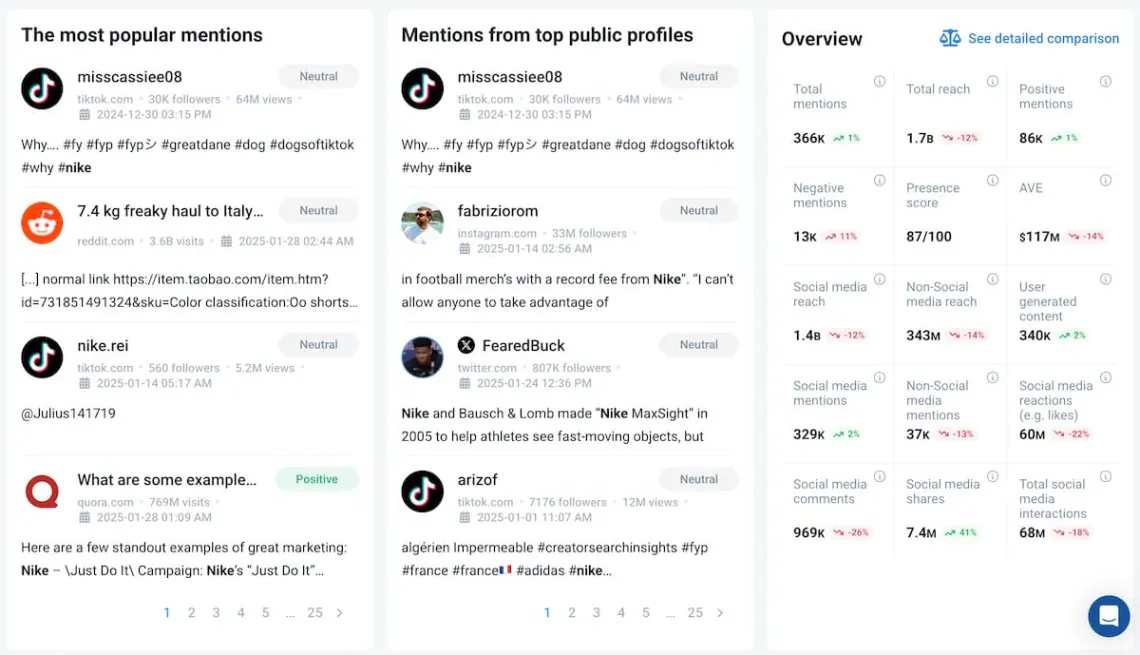
Create a competitive analysis report with Brand24!
03 Identify your main competitors
Okay, we’re constantly talking about competitor analysis. So, your next step is to uncover competitors themselves!
I think the sense of this step is obvious, so I won’t waste your time on elementary-level explanations.
Instead, I’ll share some tips and techniques to make this process fast and furio… effective:
- Identify up to 6 competitors to analyze and compare with your business. This number is enough to draw actionable insights and conclusions without spending hours on analysis.
- Focus on those offering similar products or services and operating in a similar business model.
- Diversify your analysis by mixing direct and indirect competitors to understand how emerging markets might impact your company.
- Mix both well-established companies and emerging brands. That will give your competitive landscape analysis greater depth and variety.
💡 Bonus tip: enter your customer’s brain
Seriously, imagine you’re your customer. Consider the decision-making path your customers take that leads them to you or your competitors. Then, simply follow that path yourself and list the competing brands that show up next to yours!
Now, I’ll present you three techniques that can help you identify your major competitors.
Uncover your most crucial competitors with just a few clicks!
Good old Uncle Google is a great starting point. All in all, it’s still the most frequently used search engine worldwide.
To find your competitors, simply type the keyword your customers would when researching possible brand options.
For example, in the case of the Nike brand, you can find your competitors by searching the term “sneakers brand”.

AI search
AI tools are on the rave. ChatGPT (and other similar tools like Gemini, Perplexity, or DeepSeek) are becoming the first choice when searching info for more and more people.
What are the advantages over “classic” search engines like Google?
AI tools search generates personalized responses fast, better understands the context of your question, and provides consolidated insights from multiple sources.
See also: 11 Competitor Analysis Tools You Need to Know
Especially when you’re a smaller brand searching for competitor data, AI tools can save you more time than clicking and reading many search results from Google.
For example, I prompted ChatGPT to list 10 major competitors for Tropicfeel, a lesser-known company selling sustainable clothes and equipment for travelers.
As I’m familiar with this fashion niche, I must admit that ChatGPT’s responses surprised me with accuracy!
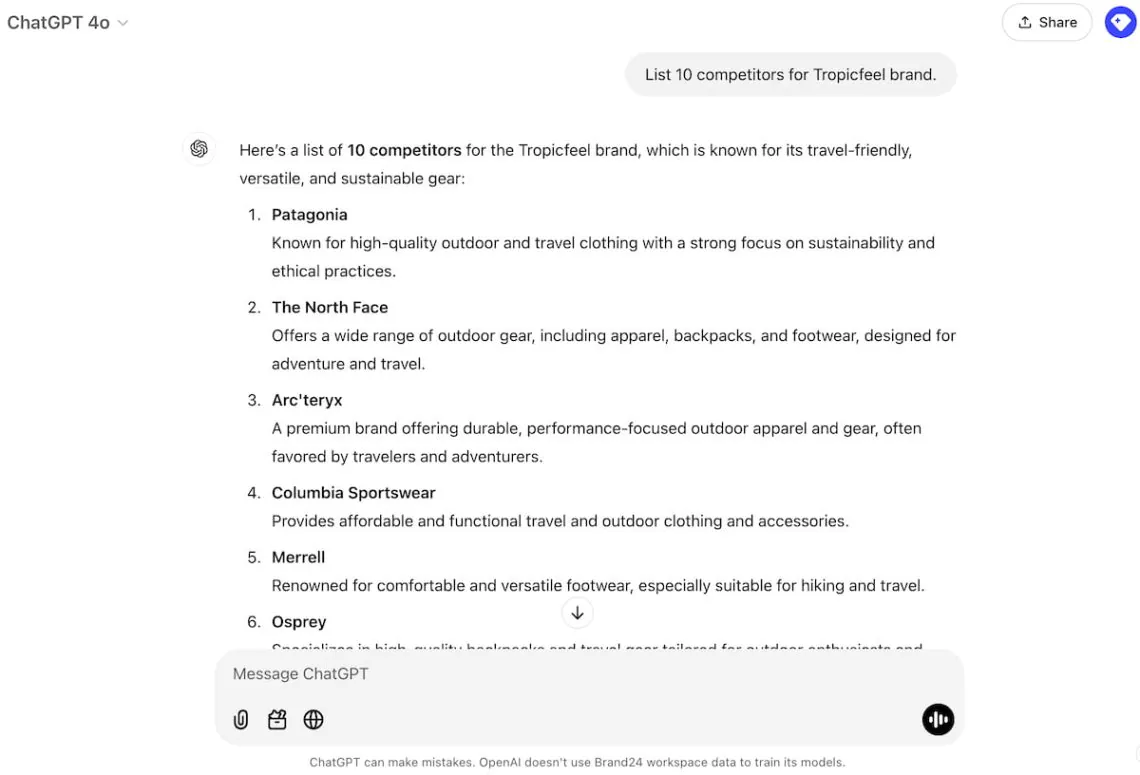
Brand24
Brand24 has a huge advantage over Google and AI search: it gathers and processes specific, internal data about your brand. That’s something generic tools can’t.
In practice, Brand24 offers a feature named AI Brand Assistant. It’s like a personalized ChatGPT that generates responses to your prompts based on your brand mentions.
And it is something as people discussing your brand online often mention competitors in the same context.
This gives you a goldmine of insights, such as which competitors are most commonly compared to your brand, how your shared audience perceives them, and what products or services are gaining attention.
When I prompted the Brand Assistant to give me direct competitors for Reebok, it gave me some interesting details. Puma, for instance, competes with Reebok in developing footwear technologies.
And that’s something you won’t discover easily with Google or ChatGPT.
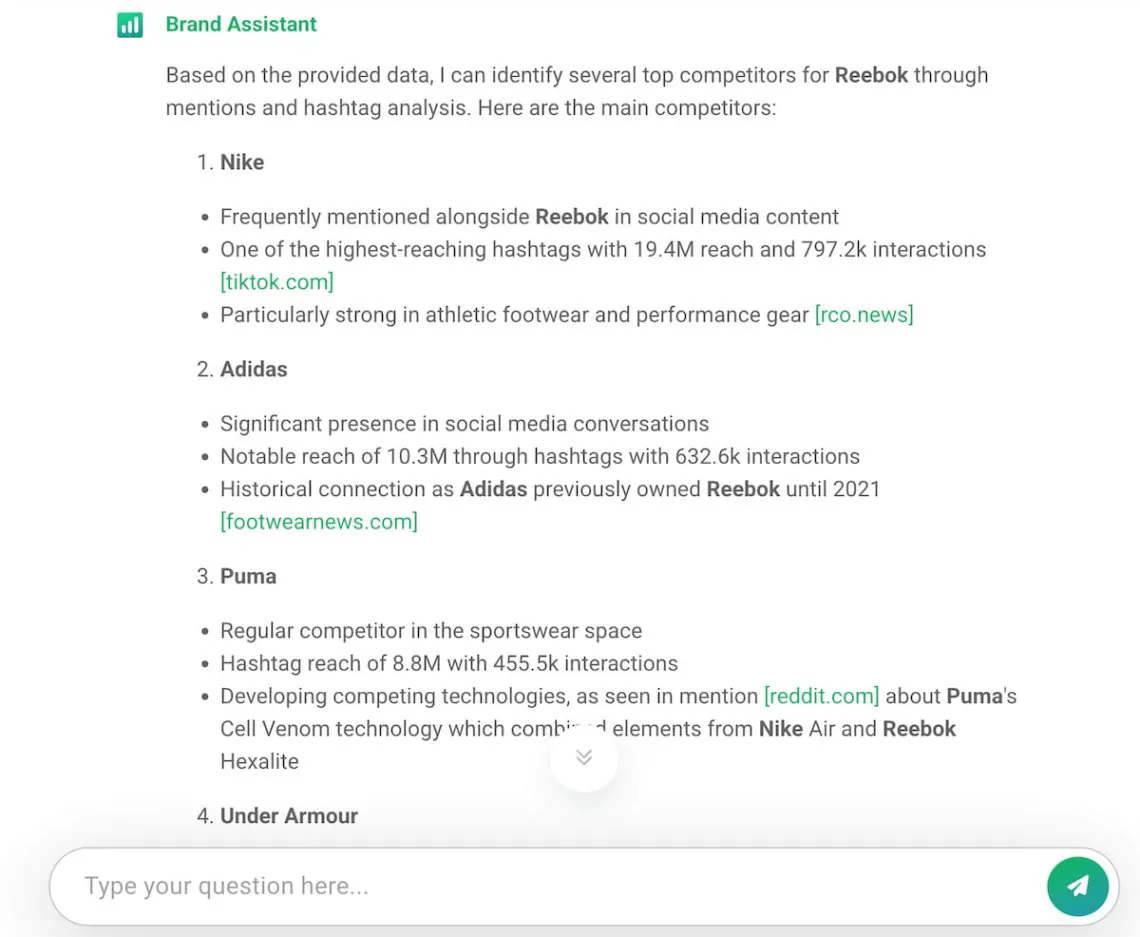
Brand Assistant knows your competitors. And you?
04 Gather competitors’ data
Now, it’s time to dive into the data-gathering phase. Before you start, remember: quality over quantity.
You don’t need to collect every piece of data. Focus on the metrics and information that align with your goals and will help you make informed decisions.
Regardless of your competitive analysis scope, here are three things to check to get incredibly valuable data about your market rivals.
Start with their website
Your competitors’ websites are a goldmine of information. Here’s what you can look for:
- Product/Service offerings: What exactly are they selling? How do they position their products? Are there any unique features or pricing strategies?
- Content marketing strategy: Check out their blog, case studies, or resources. What topics are they covering? How often do they publish?
- User Experience (UX): How easy is it to navigate their site? What’s their checkout process? Take notes on what works (and what doesn’t).
- SEO: Use tools like Semrush to analyze their top-performing pages, backlinks, and keyword strategy.
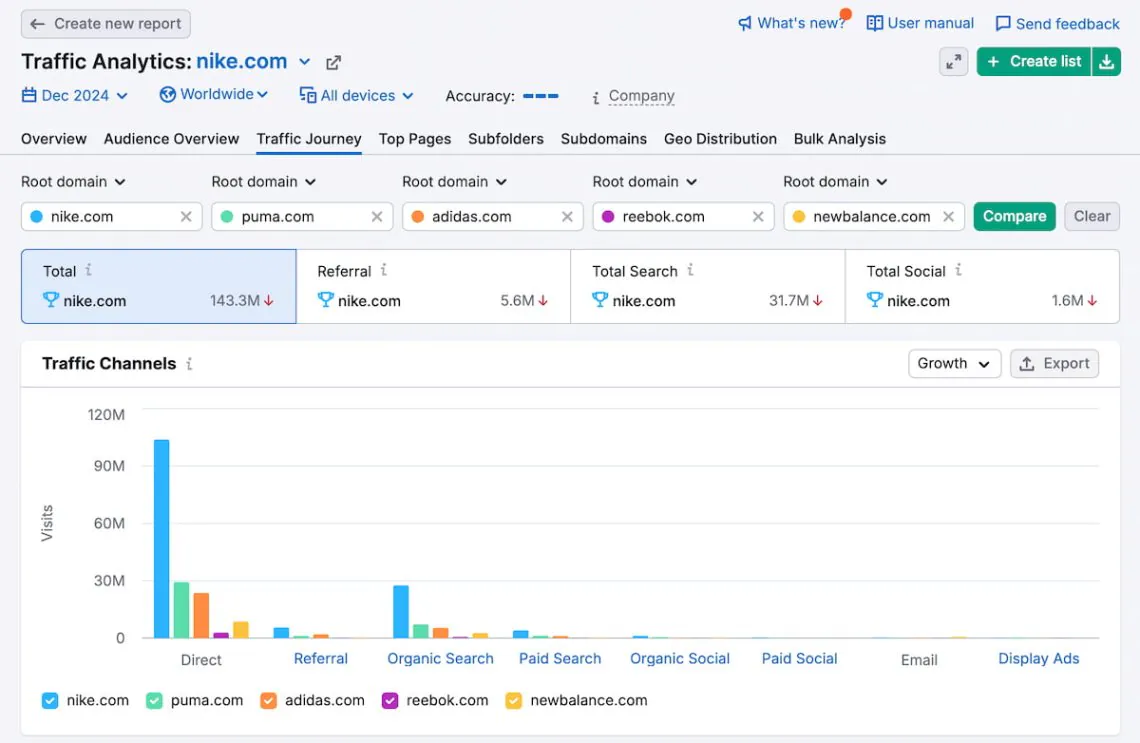
Create a competitive analysis report with Brand24!
Explore their social media
Every brand is taking care of its social media presence. Dive in and analyze:
- Platforms they focus on: Which platforms are they active on? Are they killing it on Instagram but doing bad on LinkedIn?
- Engagement metrics: Look at likes, comments, shares, and follower growth. Are their posts sparking conversations?
- Content: What type of content are they posting? Are they reels, infographics, memes, or user-generated content?
- Brand mentions: Use tools like Brand24 to discover the volume and reach of your competitors’ social media mentions and the audience’s sentiment towards them.
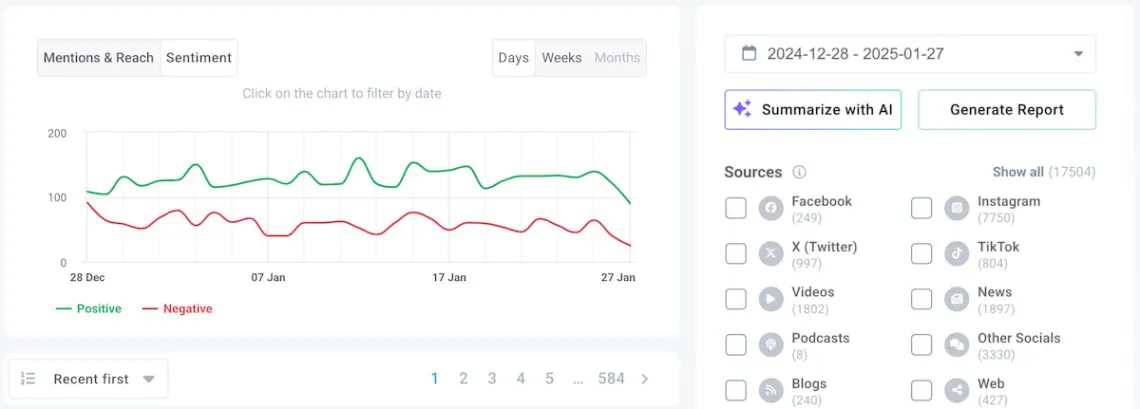
Discover brand mentions, sentiment analysis, and more!
Check their marketing campaigns
Deep-down analysis of campaigns can bring a lot of insights into your competitors’ marketing strategies. For example, you can track:
- Email marketing efforts: Sign up for their newsletters. What’s their tone? How often do they email? Are they running promotions or sharing knowledge?
- Partnerships: Are they collaborating with influencers or other brands? What kind of partnerships are these?
- Ads: Use tools like Facebook Ads Library or Google Ads Transparency Report to see what ads they’re running. What’s their messaging? What’s their target audience?

Understand your competitive advantages! Start trial!
05 SWOT analysis
Goals? Checked. Metrics? Checked. Competitors? Checked. Data? Checked.
Wow, you’re on a roll!
Okay, let’s move to the essence of the competitive analysis report, which is the analysis itself.
Here, you can make use of SWOT analysis – a classic but incredibly effective framework to evaluate both your competitors and your own business.
If you’re unfamiliar with that acronym, SWOT stands for:
- Strengths, so what your competitors are doing well;
- Weaknesses, so what they do bad;
- Opportunities, so areas where you can outperform them;
- Threats, so external factors that could harm yourself or give your rivals a competitive advantage.
A SWOT matrix is universal, so including it in your competitive analysis report template is a great idea – regardless of your report’s scope or target audience.
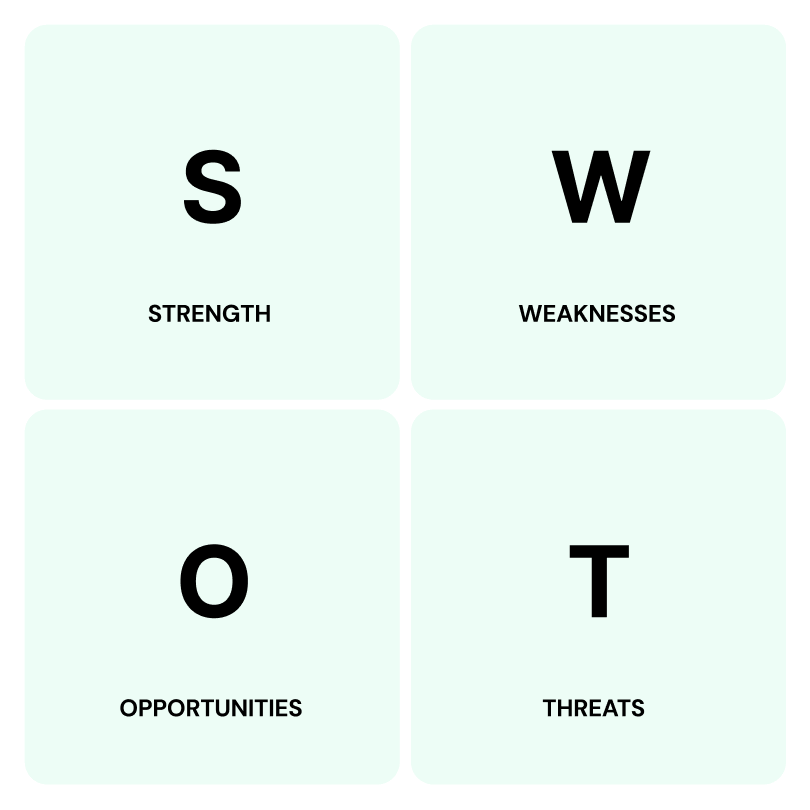
Of course, you need to fill each quadrant. You can do it manually, but there is a way to automate it. Remember I showed you Brand24’s AI Brand Assistant?
Reminder: This powerful ChatGPT-styled feature is equipped with internal data about your and your competitor’s brands. This means that you can ask it to generate a SWOT competitor analysis. Example?
I prompted the Brand Assistant to prepare a SWOT analysis for Nike, comparing it to Reebok. The result?
I received a bunch of smart and – what’s more important – accurate insights. Honestly, it would take at least one hour to discover them manually.
AI Brand Assistant did it in 15 seconds.
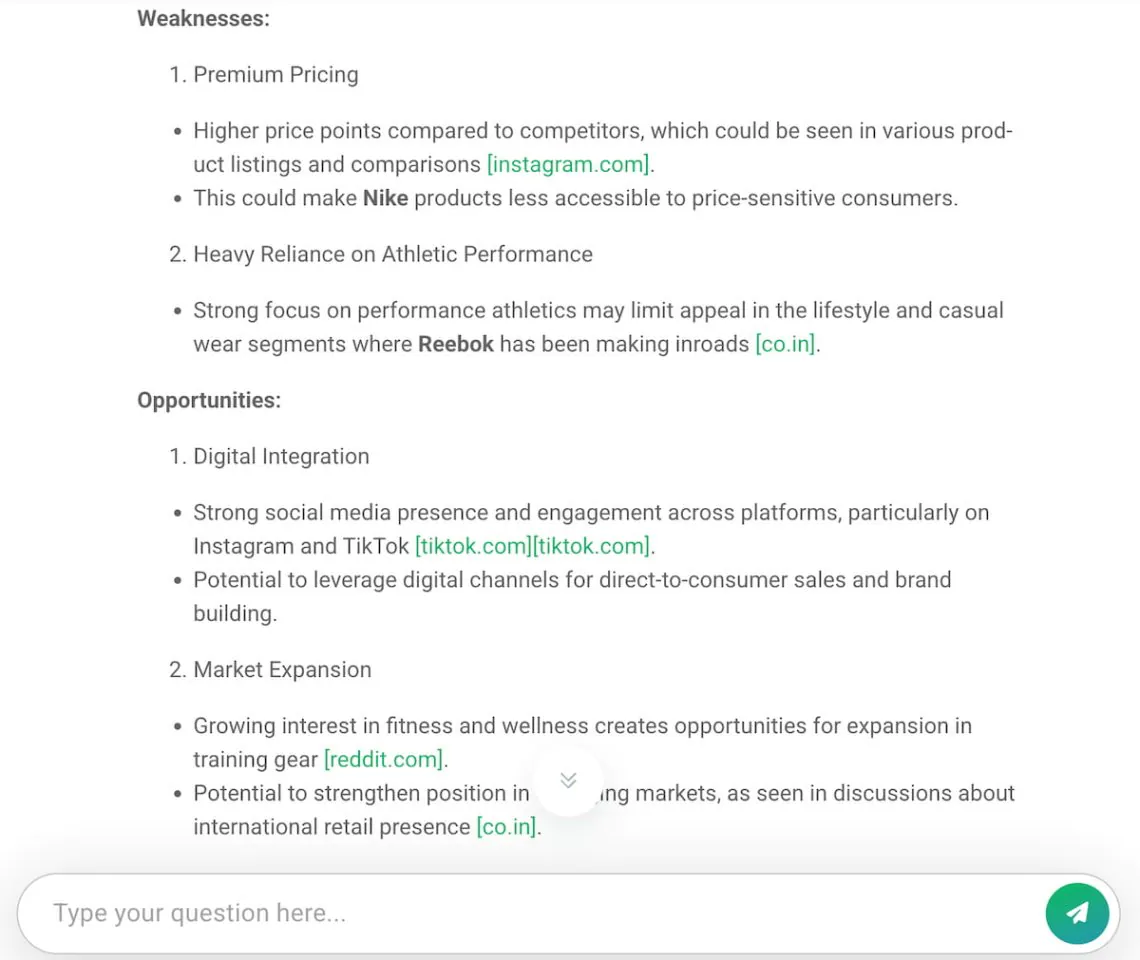
Understand your competitive advantages! Start trial!
06 Include recommendations
Now that you’ve gathered all the data, analyzed your competitors, and completed your SWOT analysis, it’s time to turn those insights into action.
This is where your competitive analysis report transitions from being informative to being transformative.
After all, the ultimate goal of this report is to help your business make smarter decisions and grow.
Remember that your recommendations should be clear, actionable, and aligned with your business strategy & goals.
Below, I present how you can structure this section.
Create a competitive analysis report with Brand24!
Identify key areas for improvement
Highlight the weaknesses or gaps in your competitor’s strategy that present opportunities for your business. Also, address your own areas that need improvements.
For example:
- A competitor has a weak presence on Instagram, which is a growing platform for your target audience (competitor weakness);
- Launch an Instagram campaign to capture more audience share and differentiate your brand (your opportunity)
Create an action plan
Turn your recommendations into a clear, step-by-step action plan.
Include timelines, responsible team members, and key performance indicators (KPIs) to track progress.
For example, your action is to launch an Instagram campaign targeting Millenials.
Your action plan can look the following:
- Timeline: by the end of the quarter (2 months);
- Who is in charge: Social Media and Content teams.
- KPI: 10,000 followers and 150,000 engagements within 3 months.
Understand your competitive advantages! Start trial!
Tailor recommendations to your audience
If you’re presenting to executives, focus on high-level strategies and ROI.
For a marketing team, dive into tactical details like campaign ideas or content calendars.
Example:
- For executives: “Investing 50,000 USD in Instagram Ads could generate 200,000 USD in revenue by Q4″.
- For the marketing team: “Create 10 reels per week, focusing on sharing informative content”.
💡 Bonus tip: Ask AI for recommendations
Some AI tools can generate automatic suggestions. Brand24 offers an AI Insights feature that provides personalized reports with trends, insights, and recommendations.
Let’s go back to our Reebok example.
According to AI Insights Recommendations, this brand can benefit from nostalgia marketing.
For example, it could develop a series that highlights Reebok’s historical impacts on memorable moments in sports.
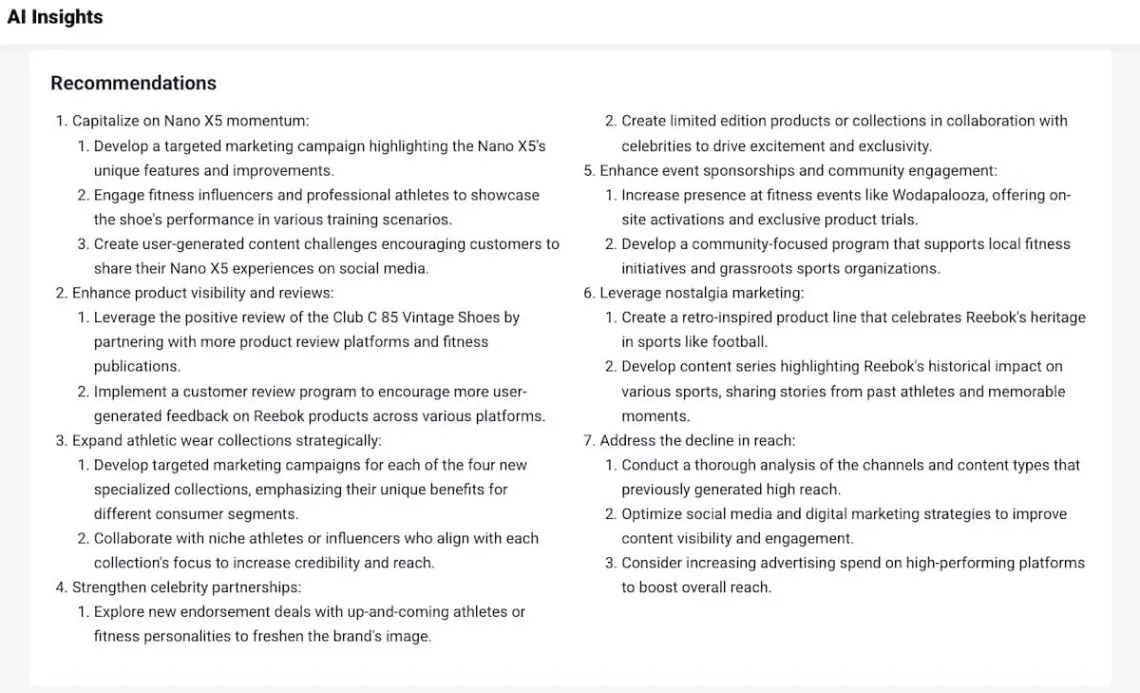
AI Insights are at your fingertips! Start trial!
07 Remember about data visualizations
Content is not enough.
Regardless of the scope of your competitive analysis report, there is one ultimate truth – it must look good.
By looking good, I mean that it should have a clear structure, be attractive, engaging, and easy to understand. Why?
We, people, are visual creatures. Our brains process images 60,000 times faster than text, and 90% of the information transmitted to the brain is visual.
Adding charts, graphs, and other visual elements to your competitive analysis report will make it more digestible, engaging, and impactful.
I highly recommend creating reusable templates for your visuals to save time and ensure consistency. It’s far more efficient than designing these elements from scratch every time.
Tools like Canva or Piktochart make this process quick and easy, even for those without advanced design skills.
Now, when it comes to choosing the right types of visuals, here’s what works best:
- Line graphs and progress bars: Perfect for showcasing growth over time, trends, or performance improvements.
- Pie charts, bar charts, and tables: Ideal for presenting audience demographics, engagement rates, or other performance metrics.
- Word clouds and scatter plots: Great for highlighting relationships between variables or identifying patterns in data.
- Screenshots: Use these to add context or provide real-world examples, such as competitor posts or ad campaigns.
- Infographics: Combine multiple data points into a single, visually engaging summary that’s easy to share and understand.

Create a competitive analysis report with Brand24!
Conclusion
Conducting a competitive analysis is absolutely crucial for understanding your market presence and discovering opportunities to outperform your rivals.
You need a clear scheme that can be incorporated into a competitor analysis report template. What should you include there?
Precise goals, essential metrics, and relevant competitor data supported by the SWOT analysis.
Also, don’t forget to include actionable recommendations and use appealing visuals to make your report impactful, engaging, and easy to understand.
With the right tools like Brand24, you can easily boost the whole process, making it both faster and more efficient.
Ultimately, a well-crafted competitive analysis report will help you make informed business decisions, upgrade your strategies, and gain a data-driven competitive edge in your industry.
Final thoughts:
- When choosing competitors for your analysis, pick up to six rivals and diversify them to have a broader picture of your competitive environment.
- Websites and social media profiles are easily accessible sources of information about your competitors, so start by visiting them.
- AI tools like Brand24’s AI Brand Assistant or AI Insights significantly help create a quality competitive analysis report faster.
Don’t wait! Start a Brand24 14-day free trial, conduct market research today, and crush your competitor analysis report!
Related articles


![How to Do an AI Competitor Analysis? Example + 8 Actionable Steps [2025]](https://brand24.com/blog/app/uploads/2021/06/2_Guide-to-competitor-analysis-with-template_2.jpg)



![4 Most Important Boeing Competitors in 2025 [Detailed Comparison]](https://brand24.com/blog/app/uploads/2025/04/boeing_competitors_digital_marketing_blog_cover_615x345-600x335.webp)

![Top 5 Biggest Airbnb Competitors in 2025 [Data-Backed Analysis]](https://brand24.com/blog/app/uploads/2025/03/airbnb_competitors_digital_marketing_blog_cover_615x345-600x335.webp)
![How to Do a Competitive Audit? The 7 Step Guide [2025]](https://brand24.com/blog/app/uploads/2024/09/business_audit_business_strategy_blog_cover_615x345-600x335.webp)


![5 Most Important Uber Competitors in 2025 [Report]](https://brand24.com/blog/app/uploads/2025/03/uber-competitors-600x335.webp)

![How to Create a Marketing Report? Template & Example [2025]](https://brand24.com/blog/app/uploads/2025/01/marketing_report_business_strategy_blog_cover_615x345-600x335.webp)
